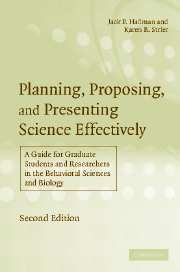 Planning, Proposing, and Presenting Science Effectively
Planning, Proposing, and Presenting Science Effectively Further reading
Published online by Cambridge University Press: 01 September 2010
Summary

- Type
- Chapter
- Information
- Planning, Proposing, and Presenting Science EffectivelyA Guide for Graduate Students and Researchers in the Behavioral Sciences and Biology, pp. 216 - 219Publisher: Cambridge University PressPrint publication year: 2006
